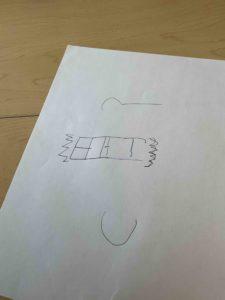An attempt at drawing a chocolate bar
Name of game: A Fake Artist Goes to New York
Creator: Oink Games
Platform: Pen and paper game
What is the theme? The theme is about drawing, with the person who doesn’t know the word being considered a fake artist. The game also capitalizes on the trope of New York, which is considered a city for art.
What mechanics do they use? Each person is only allowed to draw one line at a time, so the move has to be very strategic and take into account what has been draw, as well as what will be drawn. At the end of a round, the players vote on who the fake artist is – therefore the game is unilateral competition. However, even if the fake artist wins, they can win by naming the word being drawn. Therefore, players must balance between drawing too much (revealing the word) and too little (making it seem like they are the fake artist). In this way, this game is also similar to Spyfall, with drawing instead of naming locations.
What kind of fun do they promise the player? The game promises social fun, since there is a lot of social analysis and manipulation, as well as expression, since it allows the player to draw and express creatively.
How does the game differentiate itself from other games in its genre? The game shares elements with drawing guessing games, such as Pictionary, as well as “odd one out” games, such as One Night Werewolf. Compared to Pictionary, the drawing the collaborative amongst all players, which involves everyone in both creation and deduction. The game slso requires very few materials, compared to Pictionary which still requires the board. Compared to One Night Werewolf, there is more expression rather than manipulation, and players are all equal and have no roles.
How do they handle abuse? Abuse is not directly handled. If the fake artist tries to cheat, they could be discovered by others in the game. Overall, the game operates under the assumption that the game is casual, and any malicious behavior would be deterred by the social dynamics of the players.
How would you make it better? It would be interesting to vary the number of lines that can be drawn. Two lines allows everyone to try something in the first round, and then adapt in the second round. Perhaps adding another round could create more strategy. Furthermore, being able to choose a color for the line drawn could create more expressive capability.
One issue is that it is often hard to identify the fake artist. Perhaps adding multiple fake artists who know each other could create interesting complexity as well.



